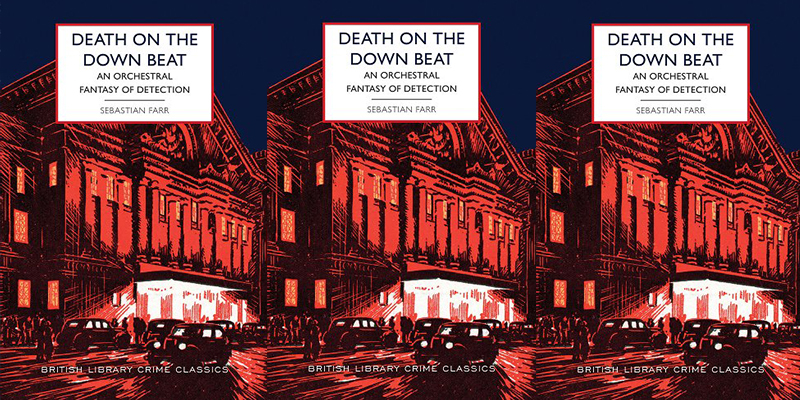Death on the Down Beat, originally published in 1941, is subtitled “An Orchestral Fantasy of Detection.” This is a highly unusual detective novel which is likely to appeal particularly to music lovers. A rare and little-known novel, it has nevertheless been described by the Golden Age mystery aficionado Barry Pike in The Oxford Companion to Crime & Mystery Writing as an “epistolary tour de force.”
Music quite often accompanies the action in detective stories (one example among many is Cyril Hare’s enjoyable novel When the Wind Blows), but here it reaches a crescendo of significance. Sir Noel Grampian, the unpopular conductor of the Maningpool Municipal Orchestra, is sensationally shot dead during a performance of Strauss’s tone poem “A Hero’s Life.” In many vintage mysteries, readers are provided with a map of the location or the floor plan of a country house which was the scene of the crime. Here, the supplementary material includes a diagram showing the layout of the orchestra, a page from the symphony concert programme, and no fewer than four pages of musical notation— all of which contain information relevant to the plot.
The story is told mainly through letters sent by Detective Inspector Alan Hope of New Scotland Yard to his wife, Julia. These are supplemented by information from newspaper cuttings and an extensive selection of letters from members of the orchestra who might be able to cast light on the killing. The late Sir Noel had the unfortunate habit of making enemies which characterises so many murder victims in detective fiction, but there are surprisingly few physical clues to the crime. As Alan complains, “At the outset there were over 2,000 suspects… However, the audience is definitely eliminated… The orchestra alone…is really under suspicion, and quite enough, too.” The pool of suspects is reduced further, so as to comprise the “permanent members” of the orchestra, but among them, motives to dispose of Sir Noel abound. A correspondent for a local newspaper advances the argument that “without a study of the score of Strauss’s [“A Hero’s Life”], no solution of the mystery can be profitably attempted.” Eventually, snippets of information gleaned from the documentary material put Alan on the right track.
The unorthodoxy of the story is fascinating, and there is some truth in the claim on the dust jacket of the first edition: “Here is something new in detective fiction.” That said, this book is also an intriguing example of the “casebook” type of crime fiction whose ancestry can be traced back to the nineteenth century. Notable early examples include Wilkie Collins’s The Moonstone, while Golden Age variations include S. S. Murder by Q. Patrick and The Documents in the Case by Dorothy L. Sayers and Robert Eustace. This is a form of storytelling which is inherently flexible, and successful modern variations on the theme include Iain Pears’s An Instance of the Fingerpost and Lucy Foley’s The Hunting Party.
Edmund Crispin, a leading Golden Age detective novelist who achieved distinction as a composer under his real name, Bruce Montgomery, regarded Death on the Down Beat as a masterpiece. Nicholas Blake, in a review for the Spectator, said:
“Musicians will appreciate both the deductions made from the musical score and the milieu of a provincial orchestra—to say nothing of the amusing feud between Maningpool’s two music critics.”
Sebastian Farr’s publishers, J. M. Dent, made a mystery of his identity. This was a marketing gimmick that Victor Gollancz had employed memorably with the first two books published by Anthony Berkeley Cox under the name Francis Iles. “Who is Sebastian Farr?” was the question emblazoned on the rear cover of the dust wrapper. According to the blurb on the first edition: ‘“Sebastian Farr’ is the pen-name of a well-known musician, who is likely to find new fame as a conductor of criminal investigation. His plot is ingenious. He is, moreover, a writer of uncommon gifts. This is (forgive the pun) a farr, farr better thing than the average detective story.”
Whether or not one is prepared to forgive the pun, those were bold words. Unfortunately, the book, like so many novels written during wartime, disappeared almost without trace. It may be as a result of disappointment that Sebastian Farr never returned for an encore. However, he achieved considerable success as a journalist and editor. In real life, he was Eric Walter Blom (1888– 1959), who was born in German-speaking Switzerland and was of partly Danish descent. He moved to Britain and spent his working life there.
While working for a music publisher, Blom taught himself music and started writing programme notes for Henry Wood’s concerts. His first post as a music critic was with the Manchester Guardian, as it was then known; he wrote notices of events in London from 1923–31. He was with the Birmingham Post for the next fifteen years before moving to London, mainly in order to work on the fifth edition of Grove’s Dictionary of Music and Musicians, a monumental work in nine volumes. He became chief music critic for the Observer, and his last article for that newspaper, on Handel, appeared the day after his death. He had a particular enthusiasm for Mozart.
According to his obituary in The Times (which made no mention of this novel), he was “shy but not unsociable and he had an almost feline wit. He was public-spirited in his voluntary work…which included the chairmanship of the Central Music Library and membership of several advisory panels. For these distinguished services to music he was made C.B.E. in 1955 and awarded a D. Litt by Birmingham University in the same year.” He married in 1923, and they had a son and a daughter, Celia, who married the journalist Paul Jennings and illustrated some of his books.
____________________


















